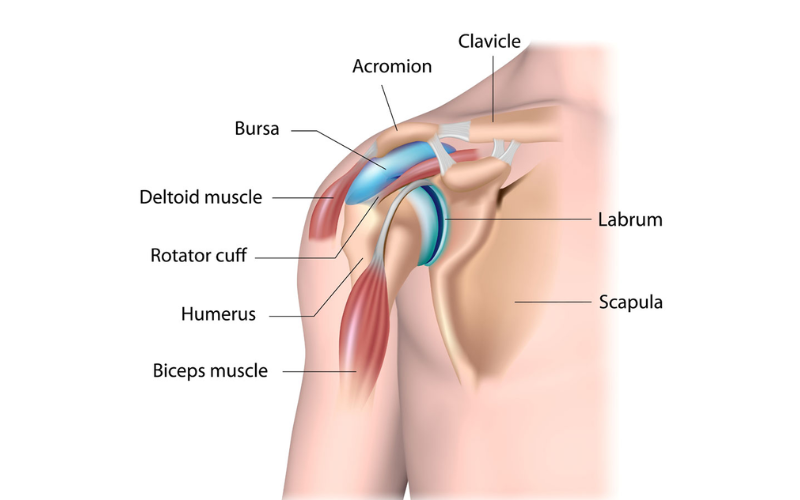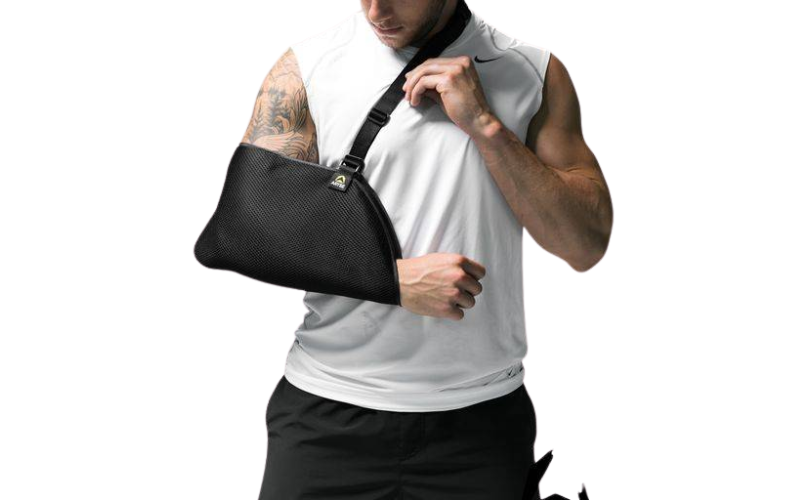Shoulder pain is a common condition, with an estimated 20% of people experiencing it at some point. Frozen shoulder and rotator cuff tears are two major causes of severe pain, stiffness, and decreased mobility in the shoulders. In fact, rotator cuff tear alone affects 2 million people in the US. These two conditions are commonly confused, so by understanding frozen shoulder vs rotator cuff, you can be more adept at getting the right treatment.
In this article, we will compare and contrast frozen shoulder vs rotator cuff injuries, causes, symptoms, and best treatments including the use of braces, slings, and other methods.
Understanding Frozen Shoulder Vs Rotator Cuff Injuries
Anatomy of Shoulder
A human shoulder is made up of three bones: the clavicle (the collarbone), humerus (upper arm bone), and scapula (the shoulder blade). It’s a ball and socket joint- the ball of the humerus bone fits into a shallow socket in the scapula.
The rotator cuff consists of four muscles that form a covering around the head of the humerus. The rotator cuff connects the humerus (upper arm) to the scapula (shoulder blade).
What is a Frozen Shoulder?
Frozen shoulder, also known as adhesive capsulitis, is a medical condition characterized by pain and stiffness in the shoulder joint. It occurs as a result of the thickening of capsule tissues that cover bones, ligaments, and tendons.
The thickening of the tissues resulting from inflammation restricts shoulder mobility. The term “frozen” in this context refers to immobility of the shoulder joint, not any drop in the temperature.
Causes of Frozen Shoulder
Major factors that contribute to the frozen shoulder include:
1. Should injury, fracture, or surgery
2. Should immobility for a long time
3. Age and gender – people between the ages 40-60, especially women are more likely to suffer from this condition
4. Other medical diseases/conditions such as diabetes, hyperthyroidism, Parkinson’s Disease, TB, and impingement syndrome may end up causing a frozen shoulder.
What is Rotator Cuff Tear?
The rotator cuff which consists of four muscles plays an important role in uplifting the arm. A rotator cuff tear occurs when any of the muscles get irritated or inflamed, often due to overuse or an injury.
The rotator cuff tear may be partial or complete. In a partial tear, a muscle is partially damaged and the person may recover with physical therapy. However, in a complete tear, the muscle is pulled off the bone completely, resulting in severe damage and extreme pain.
Causes of Rotator Cuff Tear
The following factors may contribute to a rotator cuff tear:
1. Acute injury, a sudden fall or compression
2. Age-related wear and tear
3. Heavy lifting
Frozen Shoulder Vs Rotator Cuff – What’s the Difference?
Frozen shoulder arises due to the thickening of the lining or capsule of the shoulder, which is an inflammatory process. While the rotator cuff, composed of the muscles and tendons surrounding the shoulder joint, is different from the lining of the shoulder.
The symptoms of both these conditions often overlap but rotator cuff injuries or tears are typically less restrictive in terms of stiffness than a frozen shoulder.
If you experience shoulder pain, it’s important to consult your healthcare provider. He/she will examine your shoulder and make an accurate diagnosis of your condition.
Frozen Shoulder Vs Rotator Cuff – At-Home Remedies & Treatments
1. Exercises:
If you have shoulder pain, your healthcare provider may advise performing specific exercises to enhance your shoulder mobility. Depending on your condition, they may suggest seeing a physical therapist or performing these exercises independently. It is recommended to begin slowly and avoid overexertion. Let pain be your guide – if an exercise induces too much pain, try any other exercise or discontinue it. As pain reduces and mobility improves, gradually increase the intensity of exercises for better results.
In this video, an expert has explained some useful exercises to treat shoulder pain.
2. Steroids Injections and Medications
Steroids, also known as “glucocorticoids,” can alleviate frozen shoulder symptoms for several weeks to a few months when injected directly into the shoulder joint. Prescribing steroids in pill form is not common as it may have side effects, and injections are more effective. Hydrodilatation involves injecting the shoulder with saline and glucocorticoid, which expands the joint, providing short-term relief, but it is uncertain whether the relief is due to the steroid or joint dilation. It’s not always easy to administer injections in the joint accurately so make sure you go to the right doctor for your shoulder pain treatment.
3. Shoulder Braces and Slings
If you’re experiencing pain due to a frozen shoulder or rotator cuff tear, a shoulder brace can be very useful in providing support to the shoulder joint during the healing process.
A shoulder brace is designed to stabilize the joint and restrict the patient’s range of motion but still help retain flexibility. This allows the shoulder joint to heal without undue strain while also minimizing the risk of re-injury.
There are various types of shoulder braces available in the market. The most common types of shoulder braces are:
1. Stabilizers
2. Immobilizers
3. Sling
You must choose the right type of shoulder brace that’s suitable for your condition.
Best Shoulder Braces For Frozen Shoulder Vs Rotator Cuff
1. Shoulder Immobilizer Sling
This shoulder immobilizer sling from ARYSE is designed to restrict micro-movements and immobilize the shoulder joint to promote quick healing. Made of high-performance material, this brace can be worn while exercising, driving, or doing any other physical activity while your shoulder is actively healing.
Whether you’re recovering from a rotator cuff tear, a frozen shoulder or simply looking for extra support and compression to get rid of shoulder pain, use this shoulder immobilizer brace for quick recovery.
2. Shoulder Sling
This adjustable shoulder sling from ARYSE is designed to provide the ultimate compression, support, and protection to patients suffering from a rotator cuff tear or frozen shoulder. Made up of high-quality material, this shoulder sling helps to reduce pain, and soreness and gives amazing protection to shoulder muscles so they can heal quickly.
Frozen Shoulder Vs Rotator Cuff – Where to Buy the Right Shoulder Brace?
Need a shoulder brace or support for rotator cuff, frozen shoulder, or any other shoulder injury? We, at Daphco, can offer a wide range of ARYSE shoulder braces and slings to treat various types of shoulder injuries, fractures, dislocations, rotator cuff injuries, etc.
Need more details about our shoulder braces? Contact us today.



 888-616-4156
888-616-4156 






